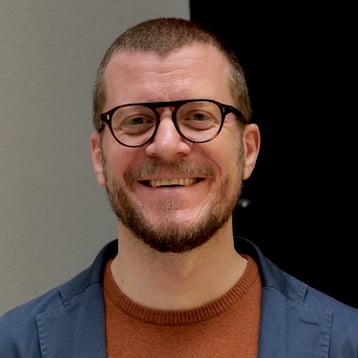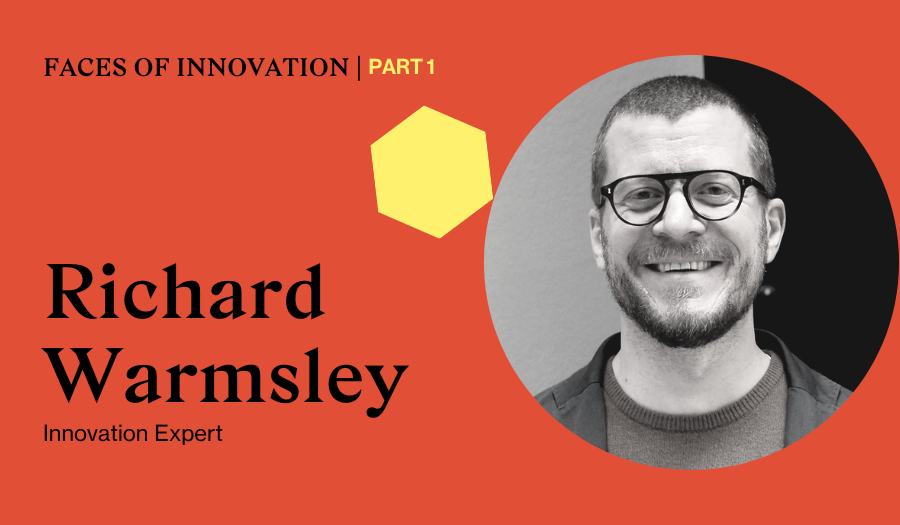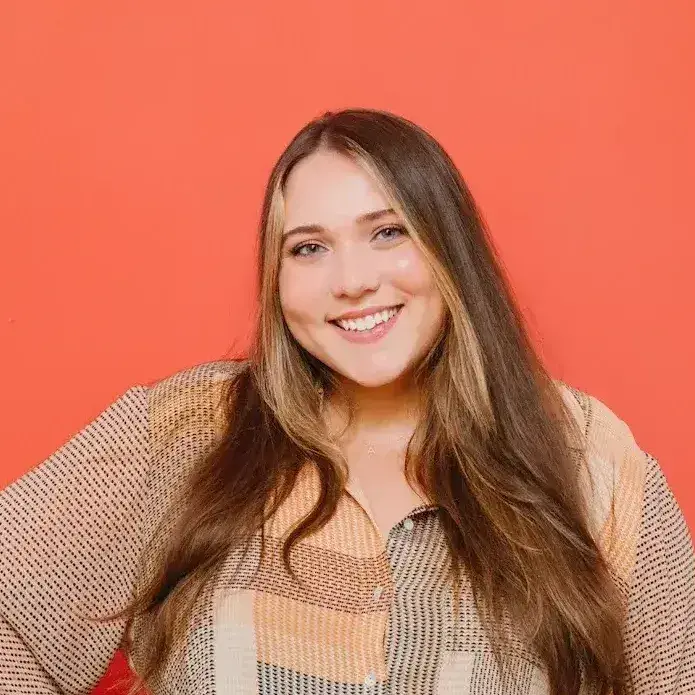
This week, we are featuring Richard Warmsley, an innovation leader with more than 20 years’ experience in designing and delivering innovation; from launching breakthrough propositions at Boots and EE, to working in leadership roles at disruptive, agile innovation consultancies to unlock insights, drive idea development and deliver growth strategies.
Could you start by talking through how your career started, how you moved into innovation and what the thinking was behind that?
When I graduated way back in 1997, I was looking around to see which companies were doing interesting things, changing the way their markets worked for customers. I nearly went to work for Bass (beer and bar innovation certainly had an appeal!), but joined a group graduate marketing programme at Boots - great training, real jobs from Day 1, seeing quick results on the shelves across thousands of towns.
But why there? At the time they were doing really interesting, innovative things with health and wellbeing (growing global brands like Nurofen, opening stores in Japan, creating a combined TV channel and website with Granada ITV, testing a gym concept, and rolling out Scandinavian-inspired dental practices in store). They were looking at their traditional pharmacy and beauty business, how it was being attacked by the supermarkets, and were probably ahead of their time in thinking about new services in health, fitness and wellbeing. This was the dot-com era, and spending big on innovation wasn’t uncommon.
This was the dot-com era, and spending big on innovation wasn’t uncommon.
Some of those Boots experiments worked - customers often loved the new stores, services and products. But most of the models proved unsustainable - it was a simple lesson that to make innovative work, you need to bring together brand strengths (in your customers’ eyes, does this new thing fit with what they think you could be good at?), customer behaviour insight (what new needs are emerging?), the right organisational talent (how can we deliver this well?) and new business models (can it deliver profitable growth quickly enough?).
For example, expensive high street retail space relies on high product sales turnover to be profitable, and doesn’t always work with big clinical practices (however brilliant the experience) unless you have a very full patient appointment book to cover the costs.
At Boots, I pitched a project to a sort of exec board Dragons’ Den - to launch an early giftcard to replace expensive secure paper vouchers - a category worth hundreds of millions. I enjoyed working with technology, commercial, creative design and marketing colleagues - it’s not easy to introduce new payment technology, new designs and store processes to systems which at that time dated back to the 1960s! Through a lot of workshops, Post-its and team tenacity, we made it work and launched for Christmas in 2003.
That taste for turning technology into great consumer products took me to the world of mobile - it seemed like an exciting, innovation and consumer tech sector at the time, growing quickly. Mobile was already unlocking flexible communication and productivity gains that seemed extraordinary. 3G was coming to bring the internet everywhere we went - that sounded like an awesome future.
How did your career develop in innovation from there?
At T-Mobile, I led proposition development and CRM marketing campaigns for the early days of mobile internet in the UK - from a few hundred thousand active customers to millions. I worked across business and consumer services, but at the time, the services weren’t really catching on. Customers would say, “why do I need the internet on my phone - I have the internet at home and in the office?” (and some colleagues would say the same, “we make our money from calls and texts, people aren’t using data”!).
So a lot of the early work was uncovering behaviour and data insights - finding out what the pioneering customers were using their browsing for, what wasn’t working for them and how could we create products and services that unlocked that scale and growth in those organisations?
I had a brilliant few years on mobile TV and music, mobile broadband and smartphones (some things flopped because use case wasn’t clear, or the technology wasn’t ready - some things just needed adjustments to unlock their potential). That culminated with launching the first Google Android smartphone at 6am on Oxford Street one morning in 2008, followed by live interviews on Sky and BBC World News.
Back then nobody was talking about apps and people hadn’t heard of Android. Working with brand colleagues, the phone featured in the T-Mobile ‘flashmob’ TV ad that went viral and became one of the world’s most watched commercials on YouTube. Seeing that product in people’s hands on the Underground was a hugely proud team moment.
Seeing that product in people’s hands on the Underground was a hugely proud team moment.
As that market matured, growth slowed, and T- Mobile and Orange became EE. I was looking across other businesses and sectors - for opportunities to design more varied products and services, and scale them up.
Talking to lots of different contacts took me into innovation consulting - originally at Market Gravity (now part of Deloitte) and then on to Fluxx (part of the Bain ecosystem of innovation partners). Working as a practitioner under experienced colleagues gave me the opportunity to really learn the craft of collaborative consulting, using commercial creativity, design thinking, agile sprints and lean start-up experiments.
The work was similar to innovation as part of a client organisation, but what was new was working closely with senior clients to shape the right kind of innovation project that would work for their particular challenge. Every organisation and every brand faces similar challenges to create new products and services, but each has different circumstances and ambitions, so needs a tailored approach. There’s definitely been a thread throughout - a hunger to do things better and wanting to turn that into reality, not just play with ideas.
There’s definitely been a thread throughout - a hunger to do things better and wanting to turn that into reality, not just play with ideas.
How has the work evolved over time?
I’ve had the opportunity to work on incredibly varied projects: leading the challenge of growing a retailer’s revenues by £1bn with new products and services; designing a project to create behaviour change for teenagers with cystic fibrosis to make them healthier and reduce the cost to the National Health Service; experimenting with prototype digital banking propositions to nudge people to save more; working out what humans want from ‘regtech’ automation of regulation processes in financial services; developing a new digital subscription transport service for a live trial in Greater Manchester to reduce congestion and pollution; and testing out how to get customers more involved in co-creating the future products a telecoms brand offers.
That range keeps you on your toes, with different teams, businesses, public bodies and technical challenges. You’ve got to adapt as you go - there are principles that cut across organisations, but projects should evolve differently day to day - not be cookie-cutter tools and processes.
You’ve got to adapt as you go - there are principles that cut across organisations, but projects should evolve differently day to day - not be cookie-cutter tools and processes.
We’re dealing with the nuances of human team colleagues, and human customers, so constantly reading the situation of a project is vital. Are we heading where we hoped? Is this going as we expected? What might get us to a breakthrough?
How do you bring those experiences together now, in terms of your current role? Coming from a client-side background into consulting…
Take away the ‘us and them’ - whether client colleagues, consultants, creatives or tech specialist, it’s just about bringing the right people together to set a direction, understand customer behaviour, test ideas and get past the obstacles.
That’s about recognising what different types of people are good at and then putting together teams that recognise those different skills. Large organisations in particular tend to have deep specialists who’ve often done their roles for quite some time. Sometimes those organisations don’t actually recognise all the strengths that they have, because it’s easy to be self-critical but there’s an incredible scale of talent, overall financial resource and unique capabilities, especially when you dig beneath the surface.
There could be some genius proprietary technology that they own or they’re particularly good at delivering a certain type of customer service experience, or they have a brilliant data analytics capability, or a new growth division somewhere in the world that has this huge potential - there is always something unique and special.
So it’s then a case of how do you marry that with an outside-in perspective that consultancies and agencies can have - looking at things with fresh eyes, asking the naïve questions, uncovering new insight, filtering ideas. Then bringing in creative skills to articulate and design early versions of products and services that ‘feel real’ - to see how people respond. People from the outside don’t know better necessarily, but they have a fresher way of looking at a market.
People from the outside don’t know better necessarily, but they have a fresher way of looking at a market.
Similarly, great people in those companies often have a natural empathy for their customers - they may not always know them as well as they think (so we have to test ideas with customers) but there is a collective intelligence built up in organisations that has kept their customers for decades or hundreds of years.
I think particularly if people have worked across different types of sectors and companies, they can bring in all of those different experiences, without necessarily being an expert in those sectors. Marry the two together - the specialist expertise and capability of an organisation and that outside-in perspective and you can really unlock the ideas that are already there.
What have you seen in terms of teams working together really well and how do you go about building teams that work in that way?
It can be tempting to focus too much on a very functional mix of team roles (someone from finance, marketing, tech, creative design, HR, etc), or the day-to-day ‘treats’ of a project room well resourced with tools, toys, drinks and snacks (nothing wrong with those if you enjoy them!). But the best teams form from more thought about bringing the right combination of characters, talents, thinking, purpose and motivation from clients and their partners.
There’s a Matthew Syed book recently published called Rebel Ideas, which gives lots of examples of the importance of diverse thinking. It can feel like the wrong word but we talk about ‘casting’ teams with a good blend of different life experience, work, skills and I thinking styles - but I also talk about hungry teams: putting people together who have a motivation to make something work.
If you put ten people in a room and tell them to innovate, and if those ten people are already busy with exciting projects, or already brilliantly rewarded, or at a stage in their career where they’re not looking to do anything new, it’s not going to work.
You need people who are - for different reasons - wanting to prove what they can do next, because true innovation involves the tenacity to get past the barriers and get over the obstacles you will have along the way. If it were easy to make it real, anyone would have done it already.
There’s always the danger of recruiting people in our own image, people who share the same interests, people who think like you. I like the phrase ‘culture add’ rather than ‘culture fit’.
Working with people from other countries, for example, means everyone can bring different life experience. But even if it’s an international team, if everyone has been to the same kind of schools or universities, tend to play the same sports or thinks the same way, it might feel less threatening, but it’s not going to produce the best results over time. Group-think, a fixed culture can be dangerously limiting. Matthew Syed gives the example of the lack of diversity in US intelligence in the lead up to 9/11.
It’s a delicate balance between people who can quickly bond from common interests (a natural human instinct), and the risk that an initial connection is superficial. Nothing goes deeper than people who aren’t the same, but who’ve overcome tough challenges together and made it through.
Nothing goes deeper than people who aren’t the same, but who’ve overcome tough challenges together and made it through.
That’s where you see joint client/innovation partner teams really shine - when they’re bonded over a pizza at 9pm trying to fix a problem (and leaving early together the next day!).
Having worked in large organisations like Boots/Walgreens and T-Mobile/Deutsche Telekom, who seemed to recruit all kinds of people, I do wonder if agency and consulting- land doesn’t always recruit people from a wide socio-economic background. Perhaps some people from wealthier backgrounds feel more secure in their circumstances and connections to manage the highs and lows of project-based life, or to feel comfortable trying out a start-up early in their career.
Or perhaps some types of education make people more comfortable with the idea of advising or leading risky projects with senior people. Whatever the reasons, although we find lots of brilliant people from a wider range of backgrounds, I think we could be missing out on growing more diverse talent. That’s going to be vital to future success.
Of course, once you’ve formed the right team blend, you’ve got to get people in a room working together and in an environment that feels like a common team - establishing shard goals, that sense that this is not ‘us and them’ and this is not handing jobs to each other or working a pure brief. We’re here to try and crack something - how we do that together?
Which also means you have that flexibility day-to- day or week-to-week to ask ‘are we going in the right direction’? We shouldn’t just be blindly following a path - the best teams decide together in an open way what’s working and what’s not and whether we’re getting closer to the outcome we’re looking for. That includes changing the mix of the team over time, to make sure we have the right talent mix in the room for what we’re trying to achieve.

